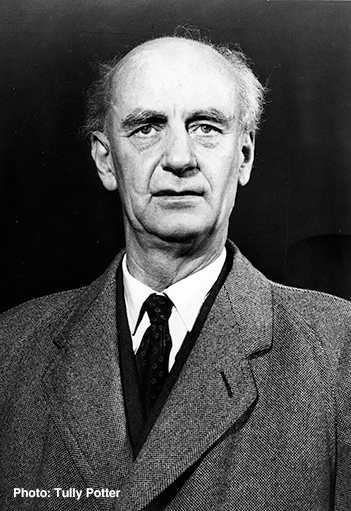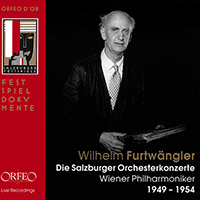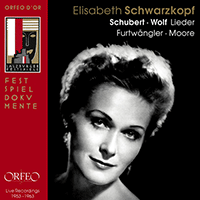Wilhelm Furtwängler
Wilhelm Furtwangler was born into a cultured middle-class German family: his father was an archaeologist and his mother an artist. As soon as it became clear that young Wilhelm was exceptionally gifted, he was taken out of school and educated at home by private tutors, including the archaeologist Curtius, the sculptor Hildebrand, and the musicologist and art historian Riezler. Music was his dominant interest: he soon learnt to play the piano and was composing when he was seven years old. His composition tutors included Rheinberger and von Schillings, and he studied piano with Ansorge. The boy was fascinated by Beethoven and is reputed to have memorised most of his works by the time he was twelve years old. By his late teens he had composed several substantial works including a symphony, a string sextet, and several string quartets. He made his conducting debut in 1906 in Munich (where in 1894 his father had been appointed professor of archaeology): the programme included a symphonic movement by himself and Bruckner’s Symphony No. 9.
Following the death of his father in 1907, Furtwangler decided to devote himself to conducting in order to support himself and his mother. He had served as repetiteur at Breslau during the 1905–1906 season, and the following season saw him at Zurich. This was followed by two years at the Munich Court Opera where Felix Mottl, who had been a close associate of Wagner, was chief conductor. Furtwangler served as third conductor under Pfitzner at Strasbourg for the 1910–1911 season before being appointed as chief conductor at Lubeck, succeeding Hermann Abendroth: here he conducted both opera and concerts. After four years he moved to a similar position at Mannheim, this time succeeding Bodansky.
By the end of World War I, Furtwangler was clearly one of the pre-eminent conductors in Germany. He was engaged to conduct the Vienna Tonkunstler Orchestra for two seasons from 1919; henceforth while he was in Vienna he would study musical structure with Heinrich Schenker. During 1920 he became conductor of the concerts given by the orchestras of the Frankfurt Opera and the Berlin State Opera, succeeding Mengelberg and Richard Strauss. Following the death of Nikisch in 1922, Furtwangler was appointed as the chief conductor of both the Berlin Philharmonic and Leipzig Gewandhaus Orchestras, and began a close association with the Vienna Philharmonic Orchestra, succeeding Weingartner as its chief conductor in 1928 (the year in which he left Leipzig) while declining the directorship of the Vienna State Opera. Although Furtwangler conducted the Vienna Philharmonic until the end of his life, it was with the Berlin Philharmonic that he was to be most closely associated. He toured at its head throughout Europe, and began to make recordings with it from 1926 onwards. He appeared in England for the first time in 1924, and in the USA in 1925, with the New York Philharmonic Orchestra, to which he returned during the following two years. However he was never subsequently to return to America: when on Toscanini’s suggestion he was approached in 1936 to become the Italian conductor’s successor at the New York Philharmonic, the public outcry was so great that he withdrew.
The rise of the Nazi party in Germany and its assumption of power in 1933 had a decisive effect upon Furtwangler’s career. He quickly ran into trouble when in 1934, following the banning of Hindemith’s opera Mathis der Maler, which he was due to conduct at the Berlin State Opera, he resigned all his musical appointments; but despite many offers from abroad, which would have allowed him to leave the country, he continued to work in Germany. Having made his debut at the Bayreuth Festival in 1931, with Tristan und Isolde, he returned to conduct there in 1936 and 1937, the year in which he also shared the conducting of the Coronation Season at the Royal Opera House, Covent Garden, with Sir Thomas Beecham, who greatly admired his musicianship. In the same year he also appeared at the Paris World Exhibition.
His desire to remain and work in Germany, despite the declining political situation and the onset of hostilities, necessarily curtailed his activities in Europe outside the countries of the Axis powers. The best that can be said of Furtwangler during this period is that he was an unwilling, if ultimately pliant, tool in the hands of the Nazi party. The reality was that the Nazi administration deliberately used culture as a key aspect of government, a fact to which Furtwangler appeared to be blind. As the pre-eminent German conductor of his generation, and one who was fully recognised as such by all from Hitler downwards, he was thus an essential part of the state’s cultural apparatus. In 1942 he conducted Hitler’s birthday concert, a key date in both the state and cultural calendars. In addition he conducted workers’ concerts – filmed for propaganda purposes – as well as the formal concerts of the Berlin Philharmonic Orchestra, and returned to the Bayreuth Festival, a recognised Nazi stronghold, in 1943 and 1944. Eventually as the Third Reich crumbled and his life became threatened, he fled to Switzerland early in 1945. Furtwangler was forbidden by the Allies from conducting until the end of 1946, when he was cleared of all allegations of collaboration with the Nazi government, although this association remained with him for the rest of his life and beyond. When the Chicago Symphony Orchestra offered him the post of chief conductor in 1949, the uproar was so great that inevitably the idea came to nothing.
From 1947 onwards, until his death at the end of 1954, Furtwangler was active in all the major European musical centres. He resumed the chief conductorship of the Berlin Philharmonic Orchestra in 1947, and from the same year onwards appeared regularly at the Salzburg Festival. He conducted Wagner’s Ring cycle at La Scala, Milan in 1950 and Beethoven’s Symphony No. 9 at the reopening of the Bayreuth Festival in 1951, and made several highly distinguished recordings for Walter Legge and the Columbia label, including an exceptional account of Tristan und Isolde. He also conducted Legge’s Philharmonia Orchestra in London and on tour, notably at the Lucerne Festival. Furtwangler suffered illness during 1952 and collapsed while conducting in Vienna in 1953, and it is believed that the drugs which were prescribed as treatment may have affected his hearing detrimentally. By the middle of 1954 it was clear that he was becoming deaf to the point where he could not hear all the instruments of the orchestra clearly: ironically this defect became obvious to the man himself at a rehearsal of his own music. With his life’s purpose thus negated, Furtwangler lost the will to live, and died shortly afterwards in a sanatorium.
If some consider Furtwangler to have been a failure as a man, there can be no question that he was one the very greatest interpretative musicians of the twentieth century. As a conductor, he possessed a highly personal technique, and completely rejected the idea of the conductor as virtuoso. Film of him conducting shows his beat to have been frequently imprecise (at times deliberately so), and his gestures often appear strangely puppet-like. He favoured a very rich bass line to his performances, the music frequently seeming to grow out of this and often realized through his evocative rather than precise gestures. Furtwangler considered music to be in a constant state of becoming: the ideal realisation of a work was thus impossible, as so much depended upon temporary factors over which the conductor had little or no control. The insistence upon the multiple recreation of a single view of a work was anathema to him, and performances of the same work conducted by Furtwangler were frequently quite different, depending upon his immediate reaction to particular circumstances. His studies with Schenker gave him a powerful grasp of musical architecture, and he had an unrivalled capacity to reveal this in performance, as well as to create a sustained sense of mood, with a mastery of tempo, phrasing, dynamics and transitions, all of which were geared to the realisation of his ideal of the moment. The results were frequently outstanding as well as unique, creating a sense of intensity equalled by few and exceeded by none.
Furtwangler’s discography is large and confusing, and needs to be approached with care. He was active in the recording studio from 1926 until his death in 1954, but not all his studio recordings were especially successful. Many however are better than critical opinion may indicate. At the same time, following the development of tape recording in Germany with the Magnetophon, an early tape-recording machine, many performances conducted by him were recorded in actual concerts during World War II, or were recorded in an empty concert hall specifically for delayed broadcast. After he resumed conducting following his post-war ban, many of his performances were recorded informally either from radio broadcasts or directly from the concert hall. These, together with the wartime recordings, have received extensive circulation alongside his commercial recordings. With the lapsing of copyright, frequently the same recording – studio or live – has appeared on different labels; thus correct identification of a recording’s provenance is worthwhile. Despite these difficulties, virtually every recording conducted by Furtwangler (and there are several mis-attributions to complicate matters) is of interest.
© Naxos Rights International Ltd. — David Patmore (A–Z of Conductors, Naxos 8.558087–90).


















